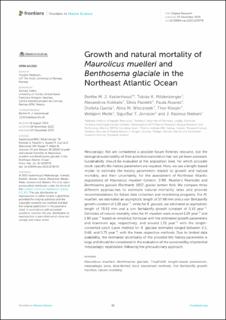Growth and natural mortality of Maurolicus muelleri and Benthosema glaciale in the Northeast Atlantic Ocean
| dc.contributor.author | Vastenhoud, Berthe M. J. | |
| dc.contributor.author | Mildenberger, Tobias K. | |
| dc.contributor.author | Kokkalis, Alexandros | |
| dc.contributor.author | Paoletti, Silvia | |
| dc.contributor.author | Alvarez, Paula | |
| dc.contributor.author | Garcia, Dorleta | |
| dc.contributor.author | Wieczorek, Alina M. | |
| dc.contributor.author | Klevjer, Thor A. | |
| dc.contributor.author | Melle, Webjørn Raunsgård | |
| dc.contributor.author | Jonsson, Sigurður T. | |
| dc.contributor.author | Nielsen, J. Rasmus | |
| dc.date.accessioned | 2024-01-16T08:45:01Z | |
| dc.date.available | 2024-01-16T08:45:01Z | |
| dc.date.created | 2024-01-12T12:20:32Z | |
| dc.date.issued | 2023 | |
| dc.identifier.citation | Frontiers in Marine Science. 2023, 10 . | en_US |
| dc.identifier.issn | 2296-7745 | |
| dc.identifier.uri | https://hdl.handle.net/11250/3111661 | |
| dc.description.abstract | Mesopelagic fish are considered a possible future fisheries resource, but the biological sustainability of their potential exploitation has not yet been assessed. Sustainability should be evaluated at the population level, for which accurate stock-specific life-history parameters are required. Here, we use a length-based model to estimate life-history parameters related to growth and natural mortality, and their uncertainty, for the assessment of Northeast Atlantic populations of Maurolicus muelleri (Gmelin, 1789, Mueller’s Pearlside) and Benthosema glaciale (Reinhardt, 1837, glacier lantern fish). We compare three different approaches to estimate natural mortality rates and provide recommendations for future data collection and monitoring programs. For M. muelleri, we estimated an asymptotic length of 57.98 mm and a von Bertalanffy growth constant of 1.28 year−1, while for B. glaciale, we estimated an asymptotic length of 78.93 mm and a von Bertalanffy growth constant of 0.41 year−1. Estimates of natural mortality rates for M. muelleri were around 1.29 year−1 and 1.80 year−1 based on empirical formulae with the estimated growth parameters and maximum age, respectively, and around 1.51 year−1 with the length-converted catch curve method for B. glaciale estimates ranged between 0.5, 0.68, and 0.75 year−1, with the three respective methods. Due to limited data availability, the estimated uncertainty of the provided life-history parameters is large and should be considered in the evaluation of the sustainability of potential mesopelagic exploitation following the precautionary approach. | en_US |
| dc.language.iso | eng | en_US |
| dc.title | Growth and natural mortality of Maurolicus muelleri and Benthosema glaciale in the Northeast Atlantic Ocean | en_US |
| dc.title.alternative | Growth and natural mortality of Maurolicus muelleri and Benthosema glaciale in the Northeast Atlantic Ocean | en_US |
| dc.type | Peer reviewed | en_US |
| dc.type | Journal article | en_US |
| dc.description.version | publishedVersion | en_US |
| dc.source.pagenumber | 14 | en_US |
| dc.source.volume | 10 | en_US |
| dc.source.journal | Frontiers in Marine Science | en_US |
| dc.identifier.doi | 10.3389/fmars.2023.1278778 | |
| dc.identifier.cristin | 2225331 | |
| dc.relation.project | EC/H2020/817669 | en_US |
| cristin.ispublished | true | |
| cristin.fulltext | original | |
| cristin.qualitycode | 1 |
Tilhørende fil(er)
Denne innførselen finnes i følgende samling(er)
-
Articles [3012]
-
Publikasjoner fra CRIStin [3066]
